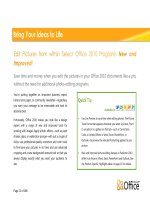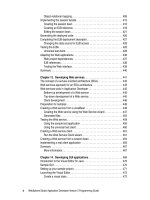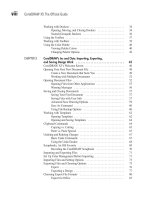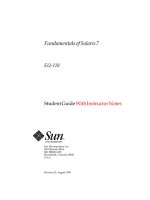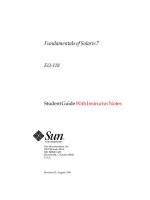solaris 9 student guide part 2 sa299 phần 1 docx
Bạn đang xem bản rút gọn của tài liệu. Xem và tải ngay bản đầy đủ của tài liệu tại đây (642.38 KB, 86 trang )
Sun Microsystems, Inc.
UBRM05-104
500 Eldorado Blvd.
Broomfield, CO 80021
U.S.A.
Revision A
StudentGuide
Advanced System Administration
for the Solaris™ 9 Operating
Environment
SA-299Please
Recycle
Copyright 2002 Sun Microsystems, Inc., 901 San Antonio Road, Palo Alto, California 94303, U.S.A. All rights reserved.
This product or document is protected by copyright and distributed under licenses restricting its use, copying, distribution, and
decompilation. No part of this product or document may be reproduced in any form by any means without prior written authorization of
Sun and its licensors, if any.
Third-party software, including font technology, is copyrighted and licensed from Sun suppliers.
Sun, Sun Microsystems, the Sun logo, Solaris, JumpStart, Web Start, Solstice DiskSuite, SunBlade, SunSolve, Ultra, OpenBoot, Java, Sun
Ray, Java Card and iPlanet are trademarks or registered trademarks of Sun Microsystems, Inc. in the U.S. and other countries.
All SPARC trademarks are used under license and are trademarks or registered trademarks of SPARC International, Inc. in the U.S. and
other countries. Products bearing SPARC trademarks are based upon an architecture developed by Sun Microsystems, Inc.
UNIX is a registered trademark in the U.S. and other countries, exclusively licensed through X/Open Company, Ltd.
The OPEN LOOK and Sun Graphical User Interface was developed by Sun Microsystems, Inc. for its users and licensees. Sun acknowledges
the pioneering efforts of Xerox in researching and developing the concept of visual or graphical user interfaces for the computer industry.
Sun holds a non-exclusive license from Xerox to the Xerox Graphical User Interface, which license also covers Sun’s licensees who
implement OPEN LOOK GUIs and otherwise comply with Sun’s written license agreements.
U.S. Government approval might be required when exporting the product.
RESTRICTED RIGHTS: Use, duplication, or disclosure by the U.S. Government is subject to restrictions of FAR 52.227-14(g)(2)(6/87) and
FAR 52.227-19(6/87), or DFAR 252.227-7015 (b)(6/95) and DFAR 227.7202-3(a).
DOCUMENTATION IS PROVIDED “AS IS” AND ALL EXPRESS OR IMPLIED CONDITIONS, REPRESENTATIONS, AND
WARRANTIES, INCLUDING ANY IMPLIED WARRANTY OF MERCHANTABILITY, FITNESS FOR A PARTICULAR PURPOSE OR
NON-INFRINGEMENT, ARE DISCLAIMED, EXCEPT TO THE EXTENT THAT SUCH DISCLAIMERS ARE HELD TO BE LEGALLY
INVALID.
THIS MANUAL IS DESIGNED TO SUPPORT AN INSTRUCTOR-LED TRAINING
(ILT) COURSE AND IS INTENDED TO BE USED FOR REFERENCE PURPOSES IN
CONJUNCTION WITH THE ILT COURSE. THE MANUAL IS NOT A STANDALONE
TRAINING TOOL. USE OF THE MANUAL FOR SELF-STUDY WITHOUT CLASS
ATTENDANCE IS NOT RECOMMENDED.
Export Control Classification Number (ECCN): 5E992
Please
Recycle
Copyright 2002 Sun Microsystems Inc., 901 San Antonio Road, Palo Alto, California 94303, Etats-Unis. Tous droits réservés.
Ce produit ou document est protégé par un copyright et distribué avec des licences qui en restreignent l’utilisation, la copie, la distribution,
et la décompilation. Aucune partie de ce produit ou document ne peut être reproduite sous aucune forme, par quelque moyen que ce soit,
sans l’autorisation préalable et écrite de Sun et de ses bailleurs de licence, s’il y en a.
Le logiciel détenu par des tiers, et qui comprend la technologie relative aux polices de caractères, est protégé par un copyright et licencié
par des fournisseurs de Sun.
Sun, Sun Microsystems, le logo Sun, Solaris, JumpStart, Web Start, Solstice DiskSuite, SunBlade, SunSolve, Ultra, OpenBoot, Java, Sun Ray,
Java Card, et iPlanet sont des marques de fabrique ou des marques déposées de Sun Microsystems, Inc. aux Etats-Unis et dans d’autres
pays.
Toutes les marques SPARC sont utilisées sous licence sont des marques de fabrique ou des marques déposées de SPARC International, Inc.
aux Etats-Unis et dans d’autres pays. Les produits portant les marques SPARC sont basés sur une architecture développée par Sun
Microsystems, Inc.
UNIX est une marques déposée aux Etats-Unis et dans d’autres pays et licenciée exclusivement par X/Open Company, Ltd.
L’interfaces d’utilisation graphique OPEN LOOK et Sun™ a été développée par Sun Microsystems, Inc. pour ses utilisateurs et licenciés.
Sun reconnaît les efforts de pionniers de Xerox pour larecherche et le développement du concept des interfaces d’utilisation visuelle ou
graphique pour l’industrie de l’informatique. Sun détient une licence non exclusive de Xerox sur l’interface d’utilisation graphique Xerox,
cette licence couvrant également les licenciés de Sun qui mettent en place l’interface d’utilisation graphique OPEN LOOK et qui en outre
se conforment aux licences écrites de Sun.
L’accord du gouvernement américain est requis avant l’exportation du produit.
LA DOCUMENTATION EST FOURNIE “EN L’ETAT” ET TOUTES AUTRES CONDITIONS, DECLARATIONS ET GARANTIES
EXPRESSES OU TACITES SONT FORMELLEMENT EXCLUES, DANS LA MESURE AUTORISEE PAR LA LOI APPLICABLE, Y
COMPRIS NOTAMMENT TOUTE GARANTIE IMPLICITE RELATIVE A LA QUALITE MARCHANDE, A L’APTITUDE A UNE
UTILISATION PARTICULIERE OU A L’ABSENCE DE CONTREFAÇON.
CE MANUEL DE RÉFÉRENCE DOIT ÊTRE UTILISÉ DANS LE CADRE D'UN COURS
DE FORMATION DIRIGÉ PAR UN INSTRUCTEUR (ILT). IL NE S'AGIT PAS D'UN
OUTIL DE FORMATION INDÉPENDANT. NOUS VOUS DÉCONSEILLONS DE
L'UTILISER DANS LE CADRE D'UNE AUTO-FORMATION.
v
Copyright 2002 Sun Microsystems, Inc. All Rights Reserved. Enterprise Services, Revision A
Table of Contents
About This Course Preface-xix
Instructional Goals Preface-xix
Course Map Preface-xx
Topics Not Covered Preface-xxi
How Prepared Are You? Preface-xxiii
Introductions Preface-xxiv
How to Use Course Materials Preface-xxv
Conventions Preface-xxvi
Icons Preface-xxvi
Typographical Conventions Preface-xxvii
Describing Interface Configuration 1-1
Objectives 1-1
Controlling and Monitoring Network Interfaces 1-2
Displaying the MAC Address 1-2
Displaying the IP Address 1-3
Marking an Ethernet Interface as Down 1-3
Sending ICMP ECHO_REQUEST Packets 1-4
Capturing and Inspecting Network Packets 1-5
Configuring IPv4 Interfaces at Boot Time 1-6
Introducing IPv4 Interface Files 1-6
Changing the System Host Name 1-9
Performing the Exercises 1-12
Exercise: The Solaris OE Network Commands (Level 1) 1-13
Preparation 1-13
Tasks 1-13
Exercise: The Solaris OE Network Commands (Level 2) 1-14
Preparation 1-14
Task Summary 1-14
Tasks 1-15
vi Advanced System Administration for the Solaris™ 9 Operating Environment
Copyright 2002 Sun Microsystems, Inc. All Rights Reserved. Enterprise Services, Revision A
Exercise: The Solaris OE Network Commands (Level 3) 1-17
Preparation 1-17
Task Summary 1-17
Tasks and Solutions 1-18
Exercise Summary 1-20
Describing the Client-Server Model 2-1
Objectives 2-1
Introducing Client-Server Processes 2-2
Introducing Client Processes 2-2
Introducing Server Processes 2-4
Starting Server Processes 2-6
Introducing the Internet Service Daemon (inetd) 2-6
Introducing Network Ports 2-9
Starting Services That Use a Well-Known Port 2-10
Starting RPC Services 2-13
Using the rpcinfo Commands 2-16
Performing the Exercises 2-18
Exercise: Observing the Solaris OE Network (Level 1) 2-19
Preparation 2-19
Tasks 2-19
Exercise: Observing the Solaris OE Network (Level 2) 2-20
Preparation 2-20
Task Summary 2-20
Tasks 2-21
Exercise: Observing the Solaris OE Network (Level 3) 2-24
Preparation 2-24
Task Summary 2-24
Tasks and Solutions 2-25
Exercise Summary 2-30
Customizing the Solaris™ Management Console 3-1
Objectives 3-1
Introducing the Solaris Management Console Toolbox
Editor Actions 3-2
Starting the Solaris Management Console 3-2
Introducing the Solaris Management Console and the
Solaris Management Console Toolbox Editor 3-4
Adding a Toolbox URL 3-17
Adding a Tool 3-17
Using the Solaris Management Console Toolbox Editor 3-19
Adding Access to a Toolbox URL of a Solaris
Management Console 3-19
Adding Access to a Tool 3-36
Performing the Exercises 3-61
vii
Copyright 2002 Sun Microsystems, Inc. All Rights Reserved. Enterprise Services, Revision A
Exercise: Using the Solaris Management Console
(Level 1) 3-62
Preparation 3-62
Task Summary 3-62
Exercise: Using the Solaris Management Console
(Level 2) 3-63
Preparation 3-63
Task Summary 3-63
Tasks 3-64
Exercise: Using the Solaris Management Console
(Level 3) 3-71
Preparation 3-71
Task Summary 3-71
Tasks and Solutions 3-72
Exercise Summary 3-80
Managing Swap Configuration 4-1
Objectives 4-1
Introducing Virtual Memory 4-2
Physical RAM 4-2
Swap Space 4-3
The swapfs File System 4-3
Paging 4-5
Configuring Swap Space 4-6
Displaying the Current Swap Configuration 4-6
Adding Swap Space 4-7
Removing Swap Space 4-8
Performing the Exercises 4-10
Exercise: Managing swap Utility Configuration (Level 1) 4-11
Preparation 4-11
Tasks 4-12
Exercise: Managing swap Utility Configuration (Level 2) 4-13
Preparation 4-13
Task Summary 4-14
Tasks 4-14
Exercise: Managing swap Utility Configuration (Level 3) 4-16
Preparation 4-16
Task Summary 4-17
Tasks and Solutions 4-17
Exercise Summary 4-21
viii Advanced System Administration for the Solaris™ 9 Operating Environment
Copyright 2002 Sun Microsystems, Inc. All Rights Reserved. Enterprise Services, Revision A
Managing Crash Dumps and Core Files 5-1
Objectives 5-1
Managing Crash Dump Behavior 5-2
The Crash Dump 5-2
Displaying the Current Dump Configuration 5-4
Changing the Crash Dump Configuration 5-4
Managing Core File Behavior 5-6
Core Files 5-6
Displaying the Current Core File Configuration 5-7
Changing the Core File Configuration 5-8
Performing the Exercises 5-14
Exercise: Collecting the Crash Dump and Core
Dump (Level 1) 5-15
Preparation 5-15
Tasks 5-15
Exercise: Collecting the Crash Dump and Core
Dump (Level 2) 5-16
Preparation 5-16
Task Summary 5-16
Tasks 5-17
Exercise: Collecting the Crash Dump and Core
Dump (Level 3) 5-19
Preparation 5-19
Task Summary 5-19
Tasks and Solutions 5-20
Exercise Summary 5-23
Configuring NFS 6-1
Objectives 6-1
Introducing the Benefits of NFS 6-2
Benefits of Centralized File Access 6-3
Benefits of Common Software Access 6-3
Introducing the Fundamentals of the NFS Distributed
File System 6-4
NFS Server 6-5
NFS Client 6-6
Managing an NFS Server 6-7
The NFS Server Files 6-7
The NFS Server Daemons 6-10
Managing the NFS Server Daemons 6-12
NFS Server Commands 6-13
Configuringthe NFS Server for Sharing Resources 6-14
Managing the NFS Client 6-20
NFS Client Files 6-20
NFS Client Daemons 6-21
Managing the NFS Client Daemons 6-22
ix
Copyright 2002 Sun Microsystems, Inc. All Rights Reserved. Enterprise Services, Revision A
NFS Client Commands 6-23
Configuring the NFS Client for Mounting Resources 6-23
Enabling the NFS Server Logging 6-28
Fundamentals of NFS Server Logging 6-28
Configuring NFS Log Paths 6-29
Initiating NFS Logging 6-31
Configuring the nfslogd Daemon Behavior 6-32
Managing NFS With the Solaris Management Console Storage
Folder Tools 6-33
Adding a Shared Directory on the NFS Server 6-33
Mounting a Shared Directory on the NFS Client 6-35
Troubleshooting NFS Errors 6-37
The rpcbind failure Error 6-37
The server not responding Error 6-38
The NFS client fails a reboot Error 6-38
The service not responding Error 6-39
The program not registered Error 6-39
The stale NFS file handle Error 6-40
The unknown host Error 6-40
The mount point Error 6-40
The no such file Error 6-41
Performing the Exercises 6-42
Exercise: Configuring NFS (Level 1) 6-43
Preparation 6-43
Tasks 6-43
Exercise: Configuring NFS (Level 2) 6-45
Preparation 6-45
Task Summary 6-45
Tasks 6-46
Exercise: Configuring NFS (Level 3) 6-49
Preparation 6-49
Task Summary 6-49
Tasks and Solutions 6-50
Exercise Summary 6-54
Configuring AutoFS 7-1
Objectives 7-1
Introducing the Fundamentals of AutoFS 7-2
AutoFS File System 7-3
The automountd Daemon 7-4
The automount Command 7-4
Using Automount Maps 7-5
Configuring the Master Map 7-6
Identifying Mount Points for Special Maps 7-8
Adding Direct Map Entries 7-9
Adding Indirect Map Entries 7-11
x Advanced System Administration for the Solaris™ 9 Operating Environment
Copyright 2002 Sun Microsystems, Inc. All Rights Reserved. Enterprise Services, Revision A
Updating the Automount Maps 7-14
Stopping and Starting the Automount System 7-16
Performing the Exercises 7-18
Exercise: Using the Automount Facility (Level 1) 7-19
Preparation 7-19
Tasks 7-19
Exercise: Using the Automount Facility (Level 2) 7-20
Preparation 7-20
Task Summary 7-20
Tasks 7-21
Exercise: Using the Automount Facility (Level 3) 7-25
Preparation 7-25
Task Summary 7-25
Tasks and Solutions 7-26
Exercise Summary 7-31
Describing RAID and the Solaris™ Volume Manager
Software 8-1
Objectives 8-1
Introducing RAID 8-2
RAID 0 8-2
RAID 1 8-7
RAID 5 8-13
Hardware Considerations 8-16
Introducing Solaris Volume Manager Software Concepts 8-20
Logical Volume 8-20
Soft Partitions 8-22
Introducing the State Database 8-23
Introducing Hot Spares and Hot Spare Pools 8-26
Configuring Solaris Volume Manager Software 9-1
Objectives 9-1
Distributing the State Database Replicas 9-2
Creating the State Database 9-2
Building a Mirror of the Root (/) File System 9-13
Creating a RAID 0 Volume 9-14
Creating a RAID-1 Volume 9-27
Executing the metaroot Command 9-40
Updating the boot-device PROM Variable 9-41
Unmirroring the root (/) File System 9-43
Performing the Exercises 9-45
Exercise: Mirroring the root (/) File System (Level 1) 9-46
Preparation 9-46
Tasks 9-47
xi
Copyright 2002 Sun Microsystems, Inc. All Rights Reserved. Enterprise Services, Revision A
Exercise: Mirroring the root (/) File System (Level 2) 9-48
Preparation 9-48
Task Summary 9-49
Tasks 9-49
Exercise: Mirroring the root (/) File System (Level 3) 9-52
Preparation 9-52
Task Summary 9-53
Tasks and Solutions 9-53
Exercise Summary 9-57
Configuring Access Control Lists (ACLs) 10-1
Objectives 10-1
Introducing ACLs 10-2
Defining ACL Entries 10-2
Introducing ACL Commands 10-6
Manipulating ACLs Using the Command Line 10-7
Determining if a File Has an ACL 10-7
Displaying ACLs 10-8
Modifying an ACL 10-10
Deleting an ACL 10-11
Substituting an ACL 10-14
Recalculating an ACL Mask 10-17
Copying an ACL List 10-18
Manipulating ACLs Using the File Manager GUI 10-21
Displaying ACLs Using the File Manager GUI 10-21
Adding ACLs Using the File Manager GUI 10-25
Changing ACLs Using the File Manager GUI 10-25
Deleting ACLs Using the File Manager GUI 10-26
Creating Default ACLs 10-27
Adding Default ACL Entries to a Directory 10-27
Effect of Default ACLs on New Subdirectories 10-29
Effect of Default ACLs on New Files 10-32
Performing the Exercises 10-33
Exercise: Using Access Control Lists (Level 1) 10-34
Preparation 10-34
Tasks 10-34
Exercise: Using Access Control Lists (Level 2) 10-35
Preparation 10-35
Task Summary 10-35
Tasks 10-36
Exercise: Using Access Control Lists (Level 3) 10-39
Preparation 10-39
Task Summary 10-39
Tasks and Solutions 10-40
Exercise Summary 10-44
xii Advanced System Administration for the Solaris™ 9 Operating Environment
Copyright 2002 Sun Microsystems, Inc. All Rights Reserved. Enterprise Services, Revision A
Configuring Role-Based Access Control (RBAC) 11-1
Objectives 11-1
Introducing RBAC Fundamentals 11-2
Roles 11-2
Rights Profiles 11-2
Authorizations 11-4
Administrator Profile Shells 11-5
Introducing the Component Interaction Within RBAC 11-6
Introducing the RBAC Databases 11-6
Managing RBAC 11-23
Managing RBAC Using the Solaris Management
Console 11-23
Managing RBAC Using the Command Line 11-57
Performing the Exercises 11-61
Exercise: Configuring RBAC (Level 1) 11-62
Preparation 11-62
Task Summary 11-62
Exercise: Configuring RBAC (Level 2) 11-63
Preparation 11-63
Task Summary 11-63
Tasks 11-64
Exercise: Configuring RBAC (Level 3) 11-68
Preparation 11-68
Task Summary 11-68
Tasks and Solutions 11-69
Exercise Summary 11-75
Performing Smartcard Authentication 12-1
Objectives 12-1
Introducing Smartcard Concepts 12-2
Solaris Smartcard Features 12-2
Solaris Smartcard Requirements 12-2
Solaris Smartcard Login 12-4
The OCF Server 12-5
Performing Smartcard Administration 12-6
Starting the Smartcard Console 12-7
Enabling a Card Reader 12-9
Activating Card Services 12-12
Adding Support for a New Smartcard 12-14
Loading the Smartcard Applet to a Smartcard 12-18
Creating User Information on a Smartcard 12-21
Activating Smartcard Operations 12-25
Configuring Smartcard Removal Options 12-28
Troubleshooting Smartcard Operations 12-31
Enabling Debugging 12-31
Disabling Smartcard Operations 12-33
xiii
Copyright 2002 Sun Microsystems, Inc. All Rights Reserved. Enterprise Services, Revision A
Resolving Smartcard Configuration Problems 12-33
Resolving Smartcard ATR Problems 12-35
Resolving Smartcard Login Problems 12-35
Performing the Exercises 12-36
Exercise: Configuring Smartcard for Desktop
Authentication (Level 1) 12-37
Preparation 12-37
Tasks 12-37
Exercise: Configuring Smartcard for Desktop
Authentication (Level 2) 12-38
Preparation 12-38
Task Summary 12-38
Tasks 12-38
Exercise: Configuring Smartcard for Desktop
Authentication (Level 3) 12-40
Preparation 12-40
Task Summary 12-40
Tasks and Solutions 12-40
Exercise Summary 12-42
Configuring System Messaging 13-1
Objectives 13-1
Introducing the syslog Function 13-2
The syslog Concept 13-2
The /etc/syslog.conf File 13-3
The syslogd Daemon and the m4 Macro Processor 13-8
Configuring the /etc/syslog.conf File 13-12
Message Routing 13-12
Stopping and Starting the syslogd Daemon 13-13
Configuring syslog Messaging 13-14
Enabling TCP Tracing 13-14
Monitoring a syslog File in Real Time 13-15
Adding One-Line Entries to a System Log File 13-17
Using the Solaris Management Console Log Viewer 13-19
Opening the Solaris Management Console Log
Viewer 13-19
Viewing a syslog Message File 13-20
Viewing a Management Tools Log File 13-22
Browsing the Contents of a Management Tools
Log File 13-25
Displaying Management Tools Log Entry Details 13-27
Backing Up Management Tools Log File 13-29
Performing the Exercises 13-34
xiv Advanced System Administration for the Solaris™ 9 Operating Environment
Copyright 2002 Sun Microsystems, Inc. All Rights Reserved. Enterprise Services, Revision A
Exercise: Using the syslog Function and Auditing
Utilities (Level 1) 13-35
Preparation 13-35
Tasks 13-35
Exercise: Using the syslog Function and Auditing Utilities (Level
2) 13-37
Preparation 13-37
Task Summary 13-37
Tasks 13-38
Exercise: Using the syslog Function and Auditing Utilities (Level
3) 13-44
Preparation 13-44
Task Summary 13-44
Tasks and Solutions 13-45
Exercise Summary 13-52
Using Name Services 14-1
Objectives 14-1
Introducing the Name Service Concept 14-2
Domain Name System (DNS) 14-4
Network Information Service (NIS) 14-5
Network Information Service Plus (NIS+) 14-7
Lightweight Directory Access Protocol (LDAP) 14-8
Name Service Features Summary 14-10
Introducing the Name Service Switch File 14-11
Database Sources 14-13
Status Codes 14-14
Actions 14-15
Configuring the Name Service Cache Daemon (nscd) 14-17
The nscd Daemon 14-17
Configuring the nscd Daemon 14-18
Stopping and Starting the nscd Daemon 14-20
Retrieving Name Service Information 14-21
The getent Command 14-21
Using the getent Command 14-22
Exercise: Reviewing Name Services 14-23
Preparation 14-23
Tasks 14-23
Task Solutions 14-25
Exercise Summary 14-26
xv
Copyright 2002 Sun Microsystems, Inc. All Rights Reserved. Enterprise Services, Revision A
Configuring Name Service Clients 15-1
Objectives 15-1
Configuring a DNS Client 15-2
Configuring the DNS Client During Installation 15-2
Editing DNS Client Configuration Files 15-5
Setting Up an LDAP Client 15-7
Client Authentication 15-7
Client Profile and Proxy Account 15-8
Client Initialization 15-8
Configuring the LDAP Client During Installation 15-9
Initializing the Native LDAP Client 15-12
Copying the /etc/nsswitch.ldap File to
the /etc/nsswitch.conf File 15-14
Listing LDAP Entries 15-16
Unconfiguring an LDAP Client 15-17
Performing the Exercises 15-18
Exercise: Configuring a System to Use DNS and
LDAP (Level 1) 15-19
Preparation 15-19
Tasks 15-19
Exercise: Configuring a System to Use DNS and
LDAP (Level 2) 15-20
Preparation 15-20
Task Summary 15-20
Tasks 15-20
Exercise: Configuring a System to Use DNS and
LDAP (Level 3) 15-22
Preparation 15-22
Task Summary 15-22
Tasks and Solutions 15-23
Exercise Summary 15-25
Configuring the Network Information Service (NIS) 16-1
Objectives 16-1
Introducing NIS Fundamentals 16-2
NIS Namespace Information 16-2
NIS Domains 16-4
NIS Processes 16-6
Configuring the Name Service Switch 16-9
Changing Lookup Requests to Go From
Files to NIS 16-11
Changing Lookup Requests to Go From
NIS to Files 16-11
Introducing NIS Security 16-14
The securenets File 16-14
The passwd.adjunct File 16-15
xvi Advanced System Administration for the Solaris™ 9 Operating Environment
Copyright 2002 Sun Microsystems, Inc. All Rights Reserved. Enterprise Services, Revision A
Configuring NIS Domain 16-17
Generating NIS Maps 16-17
Configuring the NIS Master Server 16-21
Testing the NIS Service 16-24
Configuring the NIS Client 16-25
Configuring the NIS Slave Server 16-26
Updating the NIS Map 16-28
Updating the NIS Password Map 16-28
Updating the NIS Slave Server Map 16-29
Building Custom NIS Maps 16-33
Using the make Utility 16-33
Editing the NIS Makefile File 16-34
Troubleshooting NIS 16-39
Troubleshooting NIS Server Failure Messages 16-39
Troubleshooting NIS Client Failure Messages 16-42
Performing the Exercises 16-44
Exercise: Configuring NIS (Level 1) 16-45
Preparation 16-45
Tasks 16-46
Exercise: Configuring NIS (Level 2) 16-47
Preparation 16-47
Task Summary 16-48
Tasks 16-49
Exercise: Configuring NIS (Level 3) 16-57
Preparation 16-57
Task Summary 16-58
Tasks and Solutions 16-59
Exercise Summary 16-70
Configuring the Custom JumpStart™ Procedure 17-1
Objectives 17-1
Introducing the JumpStart Procedure 17-2
Purpose of the JumpStart Procedure 17-2
Boot Services 17-3
Identification Services 17-5
Configuration Services 17-7
Installation Services 17-9
Implementing a Basic JumpStart Server 17-11
Spooling the Operating System Image 17-11
Editing the sysidcfg File 17-13
Editing the rules and Profile Files 17-15
Running the check Script 17-17
Running the add_install_client Script 17-18
Booting the JumpStart Client 17-22
xvii
Copyright 2002 Sun Microsystems, Inc. All Rights Reserved. Enterprise Services, Revision A
Exercise: Configuring a Software Installation Procedure
Using JumpStart 17-23
Preparation 17-23
Task Summary 17-23
Worksheet for Configuring a Software Installation
Procedure Using JumpStart Software 17-24
Tasks 17-25
Exercise Summary 17-31
Task Solutions 17-32
Setting Up JumpStart Software Configuration
Alternatives 17-33
Introducing the JumpStart Client Boot Sequence 17-34
Setting Up a Boot-Only Server 17-41
Setting Up Identification Service Alternatives 17-46
Setting Up Configuration Service Alternatives 17-58
Setting Up Installation Service Alternatives 17-67
Troubleshooting the JumpStart Procedure 17-70
Resolving Boot Problems 17-70
Resolving Identification Problems 17-73
Resolving Configuration Problems 17-74
Resolving Installation Problems 17-75
Resolving Begin and Finish Script Problems 17-76
Identifying Log Files 17-77
Performing a Flash Installation 18-1
Objectives 18-1
Introducing the Flash Installation Feature 18-2
Uses of the Flash Installation Feature 18-2
Flash Deployment Methods 18-3
Flash Installation Process 18-3
Flash Installation Requirements 18-5
Manipulating a Flash Archive 18-7
Create a Flash Archive 18-7
Performing Flash Archive Administration 18-9
Using a Flash Archive for Installation 18-11
Using a Flash Archive With Solaris™ Web Start 18-11
Using a Flash Archive With Interactive Install 18-40
Using a Flash Archive With JumpStart Software 18-52
Locating the Installation Logs 18-58
Exercise Summary 18-59
Bibliography Bibliography-1
Sun Microsystem Publications Bibliography-1
Books Bibliography-2
Online Help Bibliography-2
Index Index-1
Copyright 2002 Sun Microsystems, Inc. All Rights Reserved. Enterprise Services, Revision A
Preface
AboutThisCourse
Instructional Goals
Upon completion of this course, you should be able to:
● Describe network basics
● Manage virtual file systems and core dumps
● Manage storage volumes
● Control access and configure system messaging
● Set up name services
● Perform advanced installation procedures
Course Map
Preface-xx Advanced System Administration for the Solaris™ 9 Operating Environment
Copyright 2002 Sun Microsystems, Inc. All Rights Reserved. Enterprise Services, Revision A
Course Map
The course map enables you to see what you have accomplished and
where you are going in reference to the instructional goals.
Topics Not Covered
About This Course Preface-xxi
Copyright 2002 Sun Microsystems, Inc. All Rights Reserved. Enterprise Services, Revision A
Topics Not Covered
This course does not cover the following topics. Many of these topics are
covered in other courses offered by Sun Educational Services:
● Basic UNIX
®
commands – Covered in SA-119: Fundamentals of
Solaris™ 9 Operating Environment for System Administrators
● The vi editor – Covered in SA-119: UNIX
®
Essentials Featuring the
Solaris™ 9 Operating Environment
● Basic UNIX file security – Covered in SA-119: UNIX
®
Essentials
Featuring the Solaris™ 9 Operating Environment
● Software package administration – Covered in SA-239: Intermediate
System Administration for the Solaris™ 9 Operating Environment
● Patch maintenance – Covered in SA-239: Intermediate System
Administration for the Solaris™ 9 Operating Environment
● Adding users using the Solaris Management Console
software – Covered in SA-239: Intermediate System Administration for
the Solaris™ 9 Operating Environment
● Basic system security – Covered in SA-119: UNIX
®
Essentials
Featuring the Solaris™ 9 Operating Environment
● Administering initialization files – Covered in SA-239: Intermediate
System Administration for the Solaris™ 9 Operating Environment
● Advanced file permissions – Covered in SA-239: Intermediate System
Administration for the Solaris™ 9 Operating Environment
● Backup and recovery – Covered in SA-239: Intermediate System
Administration for the Solaris™ 9 Operating Environment
● The lp print service and print commands – Covered in
SA-239: Intermediate System Administration for the Solaris™ 9 Operating
Environment
● Process control – Covered in SA-239: Intermediate System
Administration for the Solaris™ 9 Operating Environment
● Hardware or software troubleshooting – Covered in ST-350: Sun™
Systems Fault Analysis Workshop
● System tuning – Covered in SA-400: Enterprise System Performance
Management
Topics Not Covered
Preface-xxii Advanced System Administration for the Solaris™ 9 Operating Environment
Copyright 2002 Sun Microsystems, Inc. All Rights Reserved. Enterprise Services, Revision A
● Detailed shell programming – Covered in SA-245: Shell Programming
for System Administrators
● Detailed network administration concepts – Covered in
SA-399: Network Administration for the Solaris™ 9 Operating
Environment
Refer to the Sun Educational Services catalog for specific information
on course content and registration.
How Prepared Are You?
About This Course Preface-xxiii
Copyright 2002 Sun Microsystems, Inc. All Rights Reserved. Enterprise Services, Revision A
How Prepared Are You?
To be sure you are prepared to take this course, can you answer yes to the
following questions?
● Can you install and boot the Solaris 9 Operating Environment
(Solaris 9 OE) on a standalone workstation?
● Can you implement basic system security?
● Can you add users to the system using the Solaris™ Management
Console software?
● Can you use the pkgadd command to add software packages?
● Can you set file permissions using access control lists (ACLs)?
● Can you monitor and mount file systems?
● Can you manage disk devices and processes?
● Can you perform backups and restorations?
Introductions
Preface-xxiv Advanced System Administration for the Solaris™ 9 Operating Environment
Copyright 2002 Sun Microsystems, Inc. All Rights Reserved. Enterprise Services, Revision A
Introductions
Now that you have been introduced to the course, introduce yourself to
the other students and the instructor, addressing the following items:
● Name
● Company affiliation
● Title, function, and job responsibility
● Experience related to topics presented in this course
● Reasons for enrolling in this course
● Expectations for this course
How to Use Course Materials
About This Course Preface-xxv
Copyright 2002 Sun Microsystems, Inc. All Rights Reserved. Enterprise Services, Revision A
How to Use Course Materials
To enable you to succeed in this course, these course materials use a
learning module that is composed of the following components:
● Objectives – You should be able to accomplish the objectives after
completing a portion of instructional content. Objectives support
goals and can support other higher-level objectives.
● Lecture – The instructor will present information specific to the
objective of the module. This information will help you learn the
knowledge and skills necessary to succeed with the activities.
● Activities – The activities take on various forms, such as an exercise,
self-check, discussion, and demonstration. Activities are used to
facilitate the mastery of an objective.
● Visual aids – The instructor might use several visual aids to convey a
concept, such as a process, in a visual form. Visual aids commonly
contain graphics, animation, and video.
Note – Many system administration tasks for the Solaris™ Operating
Environment (Solaris OE) can be accomplished in more than one way. The
methods presented in the courseware reflect recommended practices used
by Sun Educational Services.
